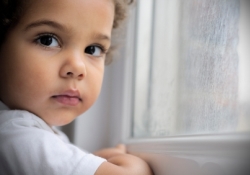 Increasingly, children are growing up in cohabiting households, rather than with married parents.
Increasingly, children are growing up in cohabiting households, rather than with married parents.
Nearly 20 percent of births today are to cohabitating parents, according to Susan L. Brown at the Center for Family and Demographic Research. Almost 40 percent of children will spend time in a cohabiting household by age 16.
Living together is now common, but it is not without consequence—particularly for children.
The effects of this family structure on children are just beginning to be understood. However, initial research by Brown and others suggests cohabitation is generally a less stable family structure than married couple or single-mother households. While there is some evidence that children in cohabiting households fare worse than those in married or single-parent families on several key indicators (Manning & Lamb, 2003), what is less clear is why. Do these negative outcomes stem from something inherent in the family structure? Or are these effects due to the types of parents who choose to cohabit (rather than to the experience of cohabitation itself)?
How does living in a cohabiting household affect both children and adults?
Impact on Children
Development
Spending extended time in cohabiting households at an early age is linked to slowed cognitive growth and language acquisition in children. Brown notes that even in stable cohabiting households, children show smaller gains in mental development. The Urban Institute finds children in cohabiting homes are also less likely to be read to than other children.
Poverty
Poverty is higher in cohabiting homes, around 23%. By contrast, the poverty rate for married couples is just 7%. Researcher Linda Waite of the University of Chicago confirms cohabiting households generally have less wealth.
Impact on Families
Effects on Women
Cohabiting mothers have more depressive symptoms than other women. These mothers also report having more difficulties rearing their children than married or single mothers, notes Brown.
Role Ambiguity
Some of the struggles in cohabiting arrangements may stem from the vaguely defined parenting role of the cohabiting partner. “The non-parent partner … has no explicit legal, financial, supervisory or custodial rights or responsibilities” toward the child of his/her partner, notes Waite. This can create uncertainty in the relationship between the child and the cohabiting parent.
Other Impacts
Men and women who cohabit are more likely than married people to experience partner abuse and infidelity, according to Waite. Children born to cohabiting households are also more likely to experience parental breakup, says Brown.
Improving Child Outcomes
Growing up in a stable married home with two biological parents appears to be a child’s best bet, statistically speaking. However, this arrangement is not always possible. If you are a cohabitating parent, here are some steps you can take to minimize negative impacts on your child.
Good Parenting
Good parenting is good parenting, period. While family structure is important, so is the individual character and conduct of all parental figures involved.
Limiting Your Child’s Exposure
Be sure anyone you bring into your home can be trusted to be a positive influence on your child. A revolving door of live-in boyfriends or girlfriends can be confusing to a child, so limit the number of significant others you bring into your home. This may make it easier for your child to attach to your partner, if and when you find someone truly worthy of commitment.
The Importance of Intent
Marriage or at least the intent to marry can make a difference. Waite distinguishes between two types of cohabitation arrangements: those who intend to marry and those who do not. Those who cohabit with the intention of marrying often share many of the (positive) characteristics of marriage. By contrast, those who cohabit without intending to marry typically have short relationships with few of these benefits.
While many people dismiss the state of matrimony as “just a piece of paper,” there are some significant differences between living together and marriage. The impact on child well-being appears to be one key such difference.
